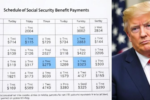For retirees juggling work and Social Security benefits, upcoming changes in income limits for 2025 could provide much-needed relief. However, navigating these changes isn’t as simple as it seems. Let’s break it down and explore how you can maximize your benefits under these new rules.
Social Security: A Lifeline with Challenges
Social Security is a critical source of income for retirees, yet many find it insufficient. Over half of U.S. adults report that these benefits don’t cover basic needs, and nearly 20% of retirees are returning to work to make ends meet. For those balancing work and Social Security, understanding the rules governing benefits is crucial.
One important rule to be aware of is the retirement earnings test, which temporarily reduces monthly payments for individuals earning above specific thresholds.
Understanding the Retirement Earnings Test
The retirement earnings test applies to retirees who:
- Receive Social Security retirement, spousal, or survivor benefits.
- Are under their full retirement age (FRA), typically 66–67 years, depending on birth year.
- Earn income from employment, such as wages or self-employment.
If you meet these criteria and your earnings exceed a set limit, your benefits will be temporarily reduced. The higher your income, the greater the reduction.
2024 vs. 2025 Income Limits
Each year, the Social Security Administration (SSA) updates the earnings test limits. The good news is that the income thresholds will rise in 2025, allowing retirees to earn more before facing reductions.
Here’s a comparison of the limits:
| Situation | 2024 Limit | 2025 Limit | Reduction |
|---|---|---|---|
| Under FRA | $22,320/year | $23,400/year | $1 for every $2 over limit |
| Reaching FRA in 2025 | $59,520/year | $62,160/year | $1 for every $3 over limit |
What This Means for You
- Under FRA in 2025:
If you earn up to $23,400, your benefits won’t be reduced. For every $2 you earn above this limit, $1 will be withheld. - Approaching FRA in 2025:
If your earnings fall below $62,160, you won’t face reductions. If you earn more, $1 will be withheld for every $3 you exceed the threshold.
Example Scenario: Impact of the Earnings Test
Imagine you’re 66 in 2025 and earn $60,000 before reaching FRA.
- 2024: Your income exceeds the $59,520 limit, so your benefits would be reduced.
- 2025: Your income is under the new $62,160 threshold, so your benefits won’t be reduced.
This example highlights how higher limits can provide financial flexibility.
Will Reduced Benefits Be Lost Forever?
No, reductions are temporary. Once you reach your FRA, the SSA recalculates your benefits to compensate for the amounts withheld. This adjustment leads to higher monthly payments for the rest of your retirement.
For instance, if a significant portion of your benefits was withheld due to high earnings, your recalculated payment at FRA will be higher than it would have been if you hadn’t worked.
The Benefits of Higher Limits in 2025
The raised income limits in 2025 are a welcome change for retirees who want to keep working. They provide:
- Flexibility: Earn more without immediate benefit reductions.
- Stability: Temporary reductions won’t impact long-term benefits.
However, it’s crucial to note that these changes require careful planning to avoid unexpected surprises.
Maximizing Your Social Security Benefits
To make the most of Social Security, retirees should:
- Stay Informed: Keep track of annual updates to income limits and rules.
- Strategize: Plan your retirement income to balance work and benefits.
- Seek Advice: Consult with a financial advisor to create a personalized plan.
By understanding the retirement earnings test and its implications, you can make informed decisions to secure your financial future.








